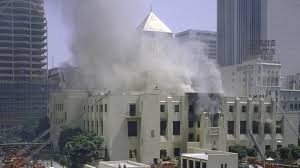GoodReads meta-data is 317 pages rated 3.91 by 78,875 litizens.
Genre: Bibliomania.
Verdict: Crackerjack.

In the morning 29 April 1986 smoke issued from air vents in the Central Library of the Los Angeles Library system. There soon followed a conflagration that required half of the City’s fire department to contain. The fire and subsequent water damage destroyed 600,000 books and damaged a like number, some of them rare, a few unique, but all representing the work, thoughts, and hopes of the individuals who wrote them and of those who read them.
The Library Book chronicles the origin and development of the Los Angeles central library with something of its branch libraries throughout the SoCal sprawl. There is a colourful cast of characters among the librarians from would-be writers, showmen, and suffragettes. This backstory is interspersed with an account of the fire and the recovery, as well as the investigation into the cause of the fire.
The fire began in one of the four closed stack silos and reached 2,500 degrees Fahrenheit, melting the steel shelves, injuring more than thirty firefighters, and cracking three-foot thick walls. More than ten percent of the drinking water of the greater Los Angeles areas was pumped onto it, least it leap to other buildings. While books do not burn easily, they do burn at 451 F-degrees as all science fiction readers know. There is an amusing description of the author burning a book to see what it is like. Which book? Well it had to be that one written in this very building by Ray Bradbury. (If you don’t know that book, tant pis).

The building by the way was designed by the same architect who had earlier done the Nebraska state capitol building with its edifying accoutrements.
The response of the library community was remarkable. When the Fire Marshall declared the site safe, volunteers (some 5000 in number) went to work pulling books out of the debris. In her words:
“They formed a human chain, passing the books hand over hand from one person to the next, through the smoky building and out the door. It was as if, in this urgent moment, the people of Los Angeles formed a living library. They created, for that short time, a system to protect and pass along shared knowledge, to save what we know for each other, which is what libraries do every day.”
Overnight local businesses found 15,000 cardboard boxes, and fish processing plants combined to free an enormous freezer warehouse to hold the damaged books until they could be assessed and restored. (Mould is a book killer when exposed to water, and freezing prevents mould.) The success rate on restoration of damaged books is low, around ten percent. For maps and art work there was no chance whatever. Plates on glossy paper and magazines have no hope.
The fire investigators concluded it was arson and pursued leads and suspects for years with no result. Despite the reassuring world of detective fiction, in fact, arson is hard to detect, harder to prove to a legal standard, and almost impossible to prosecute with a clearance rate, according to insurers, of about 1%. Caught in these investigations was one hapless Harry Peak whose strange manner of existence is, per Orlean, most likely to be found in LA where make-believe is even more common than reality. Insurance investigators were not so sure about arson, and gave up the chase. The building was fifty plus years old and full of old and new wiring for electricity, telephones, and computers, most of it installed after it was completed. Then there are all those electrical appliances from coffee machines, sewing machines for binding repair, and more.
Loved her descriptions of Los Angeles: “The sidewalks in Hollywood sagged under the weight of all the handsome young men who flocked there, luminous with possibility.”


[Hope and ambition] “are in the chemical makeup of Los Angeles; possibility was an element, like oxygen.”
For the young who come to find fame and fortune “moments were fortune cookies ready to be cracked open.” They are “lifted by the continuous supply of hope and sun.”
Everywhere you look there are “over-groomed busboys…and gym-trim extras.”
There are also many love songs to books and libraries embedded with the pages as she traces the history of the library and librarians up to the fire and then the recovery. Savour a few:
“a library is an intricate machine, a contraption of whirring gears.”
“the whole orchestral range of book-related noises—the snap of covers clapping shut; the breathy whisk of pages fanning open; the distinctive thunk of one book being stacked on another; the grumble of book carts in the corridors.”
“the city has a bloodstream flowing through it, oxygenated by books.”
“The publicness of the public library is an increasingly rare commodity. It becomes harder all the time to think of places that welcome everyone and don’t charge any money for that warm embrace.”
“Destroying a culture’s books is sentencing it to something worse than death: It is sentencing it to seem as if it never lived.”
‘There is a human mind behind every book waiting to meet the reader.”
“Libraries are the home of our oldest friends.”
The last word is this:
Heinrich Heine’s warning: “There where one burns books, one in the end burns men.”

The book is so well written I am tempted to read other of hers just to revel in the exact prose and the positive attitude that propels it. Chapeaux!

